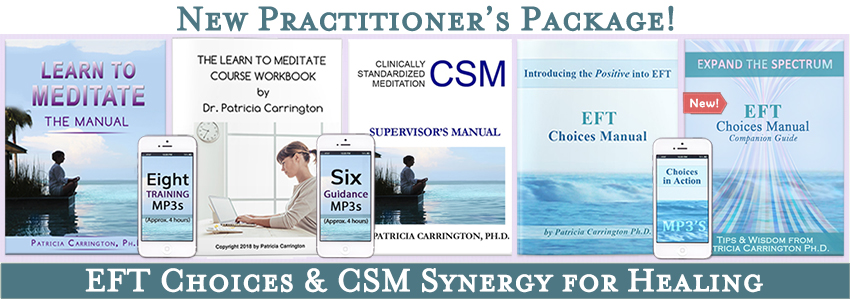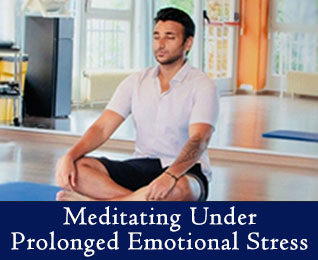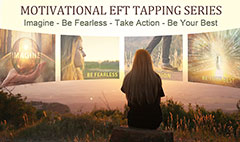
Andy Hunt is an EFT & NLP Trainer and Practitioner living in the North East of England. He works with people who give themselves a hard time and get in their own way. He is the author of the book Getting Out Of Your Own Way – Finding and Releasing Unconscious Blocks with EFT. You can visit him online at www.practicalwellbeing.co.uk.
Most people get into EFT/Tapping as a way of tackling the problems or difficulties in their lives. They use the process as a remedial tool to overcome emotional challenges.
That’s a great idea, and it’s why I started to use EFT on a regular basis. In the early years I had a lot of stuff to work with, no shortage of tap-able issues.
But there’s more to tapping than just fixing problems.
If you just use it to work on the obvious problems you can miss out on the potential of tapping to make profound changes in your life. But we can go beyond remedial tapping into using EFT to heal the hidden, wounded parts of ourselves.
In some cases these are the parts of ourselves that we don’t want to think about or admit we have, even to ourselves. These parts, the ones we wish we didn’t have are sometimes described as our shadow.
We probably don’t like to admit that we have not-so-nice parts of ourselves and we may have done a very good job of covering up those responses and feelings to fit in with our families and communities.
“One does not become enlightened by imagining figures of light, but by making the darkness conscious. The latter procedure, however, is disagreeable and therefore not popular.”
– Carl Jung
Pat C. –“This is true, except I find that sometimes we can become transformed by imagining figures of light and identifying with them on a deep level. This shifts our own vibrational level and we then operate on another wavelength. This is the principle behind such techniques as Ask and Receive, Arc of Light, the positive use of the Choices Method, etc. We can transform this way, but your use (below) of identifying the shadow side is a wonderful addition to our ways of growing whole.
Most of us aspire to be happy and good people.
When I look at Facebook, I see a never ending stream of inspirational photos and quotes encouraging us to be loving, compassionate, kind, peaceful, generous, understanding and so on. These items usually get a lot of ‘likes’ and favourable comments. (Ironically: “One does not become enlightened by imagining figures of light, but by making the darkness conscious” often appears as a motivational quote, but the second line is rarely quoted, perhaps the thought of something being disagreeable and unpopular is a bit of a downer).
If these are the ‘good’ feelings why do we need to keep reminding ourselves and each other that they are good?
Pat C. – I think because these reminders can be so superficial that we need to keep repeating them. If they become mere words repeated emptily, they can be misleading or simply bandaids. But they need not be superficial. We humans are born imitators and we learn how to live largely through imitation and that is still, in fact, the fastest way of learning, as for example when we are learning a foreign language. I think Jung was correct in pointing out what is so often neglected – the learning and healing we can derive from working with the dark side of ourselves – but it is not the only way of making us whole. I’m so grateful you are highlighting his statement in such a practical way..
If we were loving, compassionate, kind, peaceful, generous and understanding all the time these encouragements would be irrelevant.
Pat C. – Not all of them, as I just said, but a bunch of them.
Could it be that, in spite of our deepest wishes and best efforts, we sometimes feel hateful, unkind, brutal, selfish and intolerant?
If we are trying to be a ‘good person’ then it can be uncomfortable to admit or even notice that we might have some of these impulses. In fact we may spend so much time in the light that we cannot bring ourselves to notice what has been pushed away into the dark.
If I like to think of myself as kind (and I do) what do I do with the part of me that wants to be cruel? If I want to be understanding what do I do with the part of me that is intolerant?
Of course I could do some tapping, but what do I do if I barely notice that these parts of me exist?
If our aim is to be healed, become whole again, then we need to find a way of uncovering and working with what we have hidden away out of our own sight.
One way of doing this is to use the feelings, or ways of being, that are important to us, that we aspire to, to help identify the parts of ourselves that we want to disown or ignore.
Start by making a list of all the values and feelings that are important to you.
For example:
• Love
• Compassion
• Integrity
• Kindness
• Tolerance
• Generosity
• Peace
• etc
Work through the list writing down what you perceive to be the opposite of each feeling or way of being.
For example:
• Love – Hate
• Compassion – Ill-will
• Integrity – Dishonesty
• Kindness – Cruelty
• Tolerance – Intolerance
• Generosity – Selfishness
• Peace – War
• etc.
When you have created this list you may find that it is also a list of things you dislike in others.
Now for the uncomfortable bit: finding out if you have parts of yourself that embody those ‘negative’ emotions.
For each of the ‘shadow’ items on your list say, out-loud, the sentence:
“Something in me is/feels/wants [negative quality]” noticing the emotional intensity that goes with it.
For example:
something in me …
• feels hate
• feels ill-will
• is dishonest
• is cruel
• is intolerant
• is selfish
• wants war
If you find a charge on any of these statements then you have just shone a light on a disowned part of yourself.
Now you have found it what are you going to do with it?
The first step is to compassionately accept that some parts of you feel or think in these ‘negative’ ways. It doesn’t mean you are a bad person it just means that you are a human being that experiences human emotions.
The parts that are feeling, thinking or acting in these ways were probably formed a long time ago as the best available responses to challenging situations in our childhood.
Because some of these responses were unacceptable for the people around us, they may have been pushed down out of sight. On the other hand, their opposites may have been held in high regard by the people around us , shifting focus on presenting the ‘positive’ side of ourselves. In doing so, we could be praised or rewarded. Thus the selfish impulses may have been suppressed for a more favorable generosity, and so on.
You may have adopted the critical attitudes towards these ‘negative’ feelings as you grew up and find that you have strong emotions or judgments arising in you for having these parts.
The next step is to work with these disowned parts of ourselves to release or transform the thoughts and emotions that are difficult for them and us.
One way of working with these parts is to use “something in me” tapping which gives you a starting point for tapping on these parts.
This tapping process uses: “Even though something in me feels ___________, I deeply and completely accept this part of me” for the setup phrase and “Something in me feels __________” as the reminder phrase when you tap around the points.
For example:
“Even though something in me feels hate, I deeply and completely accept that part of me.” as the setup phrase and “Something in me feels hate” as the reminder phrase.
or
“Even though something in me is cruel, I deeply and completely accept that part of me.” as the setup phrase and “Something in me is cruel” as the reminder phrase.
After a few rounds of tapping, say the reminder phrase “Something in me …” (Something in me feels hate or something in me is cruel etc) to assess the emotional charge on that statement.
Keep tapping until that part of you is settled. Remember to tap on any sense of judgment or ill-will to this part of you, there is no point in being at war with yourself and that part was doing the best it could at the time it was formed.
While you do this tapping you may find that memories or other thoughts or feelings come to mind. Add these to the tapping mix and process them all, returning to the original reminder phrase to check your progress.
With the help of the tapping the part of you that responded ‘negatively’ may be sufficiently healed to find new and more positive ways of responding to the situations that it used to find challenging.
The benefits of this approach
There are several benefits to using this process:
1. Less ‘negative’ emotions to deal with: as the emotional distress of these parts is diminished your overall level of emotional suffering will reduce.
2. Greater acceptance of the parts of you: rather than spending time disowning and disconnecting from those challenging aspects of ourselves we can learn to accept them and bring them back into the greater whole.
3. Changing the ways you respond: you are less likely to find yourself responding in those ‘negative’ ways. If the part of you that was intolerant or cruel no longer needs to act in that way then you can respond more positively to those situations.
4. The ‘positive’ becomes more genuine: If you heal the part of you that is intolerant, your tolerance of others will become more genuine rather than something that has to be forced against an underlying intolerance.
5. More understanding and compassion: – the clearer and more accepting we are of our own stuff, the easier it will be to deal wisely with everyone else’s stuff.
You can find out more about “something in me tapping” in this article by Andy Hunt to improve your tapping by changing one word.
Pat C.
The something in me … tapping is not the only way of addressing these parts. You can use whatever approach works best for you, simple tapping, Matrix Re-imprinting, Core Transformation or your change process of choice.

I use a variation of the Identity Relief process that I presented in the Identity Healing training on September 27th/28th, 2014 in Newcastle upon Tyne.
This process is derived from an idea in Core Transformation, an excellent book by Connierae and Tamara Andreas that deserves to be in any serious personal or change workers library.
Pat C. – This is so valuable, Andy. Thanks!
Tap-Along with Pat, now, to tap into your shadow…..
Article shadow mage by: © Sungoot | Dreamstime.com – Long Shadows Photo






